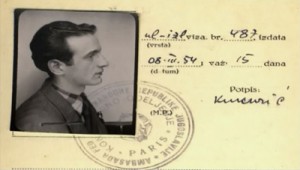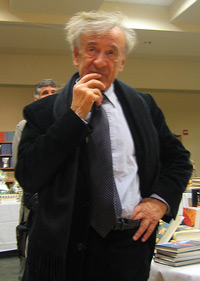Welcome
Tuesday, July 13th, 2010
We are excited to welcome you to an adventure of discovery… exploring the mystery of Elie Wiesel. This website is still under construction, but enough of the most important parts to our challenge are in place for you to understand what we are doing. Here is a brief guide to what we have and where we intend to go from here.
As you can tell from the title of this website, Elie Wiesel Cons The World, we are not pulling our punches; we believe Elie Wiesel has a great deal to answer for, and that it is time he did.
The first thing you might want to read is ‘Where is the Tattoo?’ This is the starting point of our challenge. Following that, go directly to ‘The Evidence.’ Read The Documents carefully. Even if you have already read the articles by Carlo Mattogno on the Inconvenient History Revisionist Blog [Feb., March, May 2010], and perhaps even Miklos Grüner’s book Stolen Identity, the documents here have been ordered to make a complex trail easier to follow. As new and pertinent documents come into our hands (and they will), we will add them to this page.
Also important in understanding the duplicity inherent in the Elie Wiesel legend is the analysis of the ‘Famous Buchenwald Photo,’ which it would be good to read next. By now, you may be floored and need to take a break. Some reflection at this point might be in order so that one does not take a hard position either for or against this information.
ACTIVISM
We want to promote a populist style of activism, thus we have Projects on our menu bar. So far, we have prepared a project called Boston University. This is the institution that has provided a haven of respectability for Wiesel for many years, and where he pretty much does and comes and goes as he wishes. After reading this page, and if you agree with us, we hope you will begin to act on our suggestions. We believe we are fully within our rights, and even our obligation, to demand the Department of Philosophy, under Department Chair Professor Daniel Dahlstrom, examine the background of Professor Wiesel, just as it would any other member of its academic community/department.
RESEARCH
We are doing research on this matter that should have been done in the past but was not. We place it under Projects on the menu because everyone can research these issues, and we encourage each one of you to join in this work. If something intrigues you, or you would like an answer to a question in your mind, go after it. You may go down a rabbit hole and come up with gems no one else has discovered. There is so much mystery, so much confusion, so many contradictions, unknowns, surrounding Elie Wiesel, it is still largely unexplored territory for researchers.
One area we’re looking into is Elie’s whereabouts between 1945 and 1955. When did he first go to Israel? When did he go to Buenos Aires where his book Night was published? When and how did he meet the successful author Francois Mauriac, who drastically shortened and practically rewrote Night?
There is a group photograph of the orphans at Ambloy, France. The USHMM states that Elie is among them, but we haven’t been able to find a face that resembles his. (I wrote to the Museum asking them to point out which one was Elie, but have received no answer.) There is a picture of Elie on a boat, supposedly on his way to Israel in 1949. Was this his first trip there?

Elie Wiesel in 1954, age 26 (NOT)
There is an “entry card to France” (not a passport) dated 1954 with Elie’s current profile—he looks very young and slender. We think this Elie looks younger than the alleged Elie in the 1945 Famous Buchenwald Photo, which was taken 9 years earlier. How are these matters reconciled? UPDATE: Six years later, in 2016, I have realized this is NOT a picture of Elie Wiesel. It seems to resemble him, but Elie Wiesel was heavier and older-looking in 1954. His hair was dark, longish and wispy, not tightly curled. I don’t want to remove what I originally wrote here since it’s been available so long, and additionally it’s a confirmation for others who have been fooled by this image that it is NOT Elie Wiesel after all.
WHY ELIE WIESEL?
How did Elie Wiesel become the world’s most famous holocaust survivor? Did he do anything exceptional? Did he suffer more than others? Our answer to both is no—in fact, to the contrary. What he did was to write a book that became the most famous book about The Holocaust. That book is Night. It’s been required reading in many high schools and colleges for years, guaranteeing it exceedingly high sales. Who decided that this book was exceptional? The reading public? It was slow to gain any sales or recognition. It took three years to sell the first 3000 copies of the 1960 English translation, according to Wiesel himself. What happened to change that? We have not yet found a single comment to explain it, but like all successful books, music, movies, it needed an influential and well-heeled promoter(s) and it obviously got one. Who is or are these persons?
The book itself adds immensely to the suspicions about Wiesel, and we intend to do an in-depth investigation of Night. It was presented as fiction in its first editions; and re-categorized as non-fiction about the time when it started to really sell. But the account Wiesel gives of Auschwitz-Birkenau is fictional indeed, not conforming to the accepted historiography of the camp during the time he was supposedly there. For example, there is no mention of homicidal gas chambers in Night, which were allegedly working day and night during the summer of 1944 with the arrival of the Hungarian Jews, but he did write about outdoor pits of fire to which he was several times led with a group of others to be burned alive, but—with no explanation to the reader at all except “a miracle”—at the last minute the Germans directed him elsewhere. Strange things like that.
When he injures his foot, instead of being sent to a gas chamber (or the burning pit) because he is no longer useful, he is put into a hospital where surgery is performed on his foot! Not only that, his father is allowed to stay there with him. When the SS are abandoning the camp in January 1945, Wiesel chooses to go with them to another camp in Germany rather than wait for the Russian liberators, which over 7000 inmates did. They were still there when the Russians arrived.
Elie Wiesel has never adequately addressed these and other problems in Night. He is never asked to address them, except by revisionists. That most likely explains why he’s said, on different occasions, that he doesn’t want to be in the same room with a revisionist. His only answers are that there are no answers. “I cannot explain it,” he says.
With this website, we are asking Elie Wiesel to explain himself, to answer for himself. We are asking hundreds, and thousands, of you to ask him too; indeed, to demand that he respond to these questions. This is our beginning. Where we will end up is yet to be known.
Category Featured | Tags: Tags: Night,
Social Networks: Facebook, Twitter, Google Bookmarks, del.icio.us, StumbleUpon, Digg, Reddit, Posterous.


